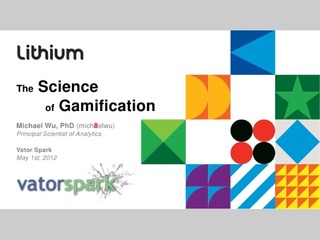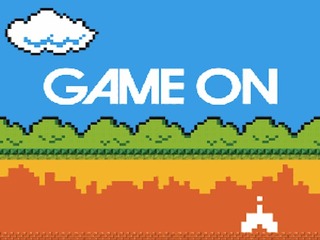Studying History: How Westward Expansion Still Inspires Small Businesses
How the Legacy of Westward Expansion Continues to Inspire Small Business Owners
Read more...At Vator’s first Spark event, the focus was on gamification. Here's the video of the panel: "How startups can benefit from gamification techniques and best practices." On this panel were Raja Paharia, CEO and founder of Bunchball, Niel Robertson, CEO and founder of Trada, Kris Duggan, CEO and founder of Badgeville, Tim Roberts, VP of interactive design at Fitbit and moderator, Brian Blau, research director at Gartner.
Here are some highlights (slightly edited):
Blau: What's the value of gamification for startups?
Paharia: I'm an engineer by training and temperment. One really sad day, I woke up and realized I couldn't get anyone to use a product I had built. There's this huge gap that entrepreneurs don't realize. How do they get someone to use something they've built? People can build software, but not everyone knows how to get people to use it. Gamification is the tool to motivate people to want to engage with your product.
Roberts: The first time we saw gamification, it was in a product that wasn't designed as a gamification feature. It was just the number of steps a person takes. Just that number is really powerful to people. That transparency and awareness to the point where people say, "I left my Fitbit. I won't get credit for what I did today." Behavior change is in the essence what we’re trying to do. One of the questions to ask is: What are your users going to embrace? What are the game mechanics they’ll really like and find fun? Create features that accomplish goals for them as opposed to accomplish goals for your business.
Blau: Give an example of something you’ve seen, where a start-up has used gamification effectively?
Duggan: Firstly, it's not about thinking of gamification as the end, but the means. Sometimes it’s surfacing performance metrics, sometimes it’s about showing them what other people are doing. We have 150 customers and one small startup that is our customer is called BeattheGMAT. It's a small community of active loyalist users contributing to help other people beat the GMAT. By adding game mechanics and rewarding players for curating and adding content, they were able to significantly boost their key metrics. Their time on site was boosted by 300%. Another metric was how much content was created. They creaed a game called the tagging game and motivated users to create tags around the content and 80,000 articles were able to be curated in two weeks. Motivate your users to create real value.
Blau: Give examples of startups that have done a good job with gamification.
Robertson: Where people fail with gamification is when there’s no real underlying data experience if gamification was there or not. If there’s no real mechanism that has a data-centric view of how they look at building and testing. People just throwing badges on things but it’s not related to what someone wants to achieve. It's very important that the underlying thing you’re doing is the primary activity and gamification happens passively in the background... It’s like a salesman. You can’t constantly change his compensation to do better. Sometimes that person just has to want to make 100 phone calls a day. You can’t fundamentally change the core of the thing you’re trying to affect.
Blau: What are common mistakes that small companies make and how can gamification help that?
Paharia: Foursquare is a great case study. Foursquare on day one had no inherent value. They have no data; they have no city guide. Yet they need you to check in to generate the data and get the flywheel going. So what do they do? They realized that gamification as an on-boarding tactic was effective. So they added mayorships, added points and badges. That got people playing Foursquare. It was an incredibly good onboarding tool. But now Foursquare’s challenge is sustaining engagement. Game mechanics cannot sustain the engagement. You’ll play Fourscquqre and at some point you’ll say, “What value am I getting?” That’s the key moment of truth. First moment: How do you get people to press the button?Second: How do you get people to keep pessing the button? Now Foursquare is trying to figure out what the value it is they’re giving to their users.
Roberts: I look at the analytics side. We use Mix Panel and Google Analytics. But doing it and getting it right and having confidence in those numbers, and making sure you’re investing in that continually. It's not easy. Second part is doing something with those numbers. Having people accountable for that stuff is really important. What's challenging, but less obvious is the legacy stuff. You have a whole lot of users attached to things you’ve launched. Changing those things gets harder and harder to do. Finding that balance between doing stuff quick and having users use it is great to a point. But having a great enough of foresight to not create a massive legacy issue is also important.
Robertson: I plus 1 what Tim just said. We didn’t instrument as early as possible. Part of our challenge is our game mechanics around reputation system has left the building. People will list I’m a level 4 Trada optimizer on LinkedIn because they think it’s valuable. That’s fantastic but it’s hard to tell people you’re getting rid of that leveling system. This is the problem with the law of little data. So my guidepost is to not be overly academic about this. Pick one or two things you think are fundamental to the kind of engagement you want. Work with enough data to make decisions. We’re surprised when every time we put in a new gamfiication system, a bunch of people used it the way we thought, a bunch hack around it, and then there's a bunch of side effects we never thought about. Every game mechanics has a lot of unintended consequences.
Blau: Advice to startups?
Robertson: Spend time and energy on core product and solve the on-boarding with gamification.
Paharia: Focus on one thing, and one thing really well. If you’re launching a community, then the core piece is to have a successful community where people are activated and contributing. Think of what the behavior design is to reduce risk and increase results.
Roberts: Once you figured out the core thing, then treat it as a KPI (key performance indicator) and think about it and check in on it regularly and manage to it.
Duggan: Provide meaningful value. If there’s no meaning, then there’s no value. You have to be providing meaningful value to end user. No. 1 mistake with gamification is when there's an uneven value exchange.

Founder and CEO of Vator, a media and research firm for entrepreneurs and investors; Managing Director of Vator Health Fund; Co-Founder of Invent Health; Author and award-winning journalist.
All author postsHow the Legacy of Westward Expansion Continues to Inspire Small Business Owners
Read more...Top three lessons learned: Stay Humble; Don't Quit; Show Up
Read more...
Joined Vator on
I've spent my entire career crafting great product experiences. Currently the VP, Interactive & Design at Fitbit.
Joined Vator on

Joined Vator on
Brian is a Research Director in Gartner's Consumer Technology and Markets group. He covers consumer social networks, social analytics, video games, mobile devices and OS's and the connected consumer.
Joined Vator on
Founder, Chief Product Officer at Bunchball


